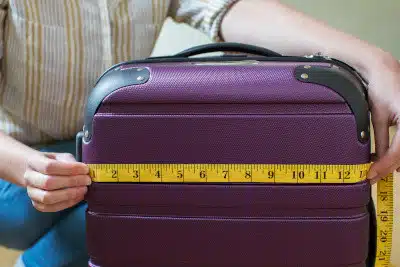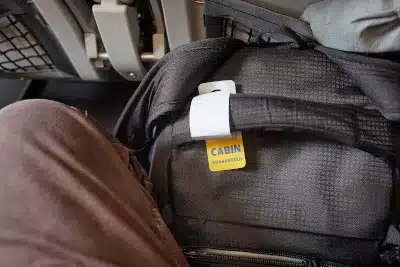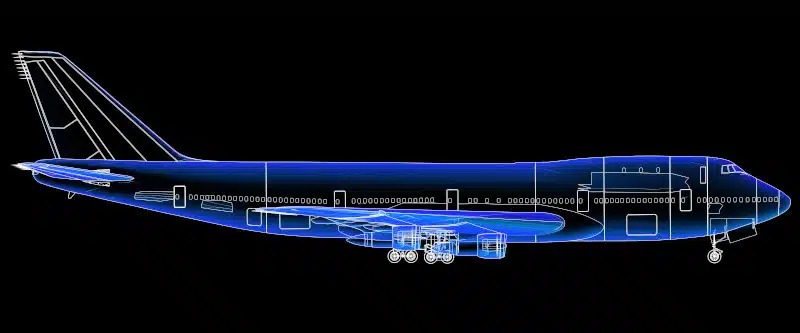Navigating the intricacies of airline baggage policies can often feel like deciphering an elaborate code. And when it comes to underseat luggage — a convenient option that allows you easy access to your travel essentials — understanding size limitations is vital. In this article, we’re going to unravel these complexities and offer you a comprehensive guide to help you navigate the world of underseat luggage with ease.
In an era of burgeoning baggage fees and increasing onboard storage issues, the underseat space is your secret weapon to travel light, smart, and efficiently. This often-overlooked spot can house everything from your laptop and reading material to snacks and other essentials that can help make your journey more comfortable. But the key to maximizing this space lies in understanding the size and weight restrictions set by different airlines.
From budget-friendly carriers to full-service giants, every airline has its unique baggage policy. In this guide, we’ll break down these guidelines for you, so whether you’re jetting off on a quick business trip or embarking on a long-haul journey, you’ll have all the information you need to choose the perfect underseat luggage. So sit back, relax, and let us steer you through the ins and outs of underseat luggage dimensions. Welcome aboard, and let’s set off on this journey together!
What Is Underseat Luggage?
Underseat luggage refers to the bags, cases, or items that can comfortably fit under the seat in front of you on an airplane. While most travelers are familiar with the overhead compartment for storing carry-on luggage during a flight, the underseat space is an often overlooked but equally important part of your in-flight storage options. This space is ideal for housing items that you might need during your flight, such as a laptop, books, headphones, snacks, or travel documents.
Underseat Luggage Size
The size of underseat luggage is crucial because it needs to fit comfortably in the limited space beneath the seat in front of you. Although exact dimensions can vary depending on the specific airline and aircraft model, a common guideline for underseat luggage size is typically around 18 x 14 x 8 inches. However, this is not a standard size and it’s always recommended to check the airline’s official baggage policy to confirm their specific underseat luggage size restrictions.
Underseat Luggage Weight
Unlike checked and carry-on luggage, airlines typically do not impose specific weight restrictions for underseat luggage. The unspoken rule, however, is that it should be light enough for you to be able to lift and handle the item without assistance, ensuring safety during the flight. However, as policies can vary between airlines, it’s always a good idea to confirm this with the airline before your journey.
Underseat Luggage Fees
In most cases, underseat luggage is considered as a personal item and is included as part of your free cabin baggage allowance. This means that, in general, you should not expect to pay additional fees for luggage stored under your seat, as long as it complies with the airline’s size restrictions and doesn’t exceed your total cabin baggage allowance. However, some low-cost carriers might have more stringent policies, and it’s possible that fees could apply if your underseat item is over the size limit or if it’s an additional piece beyond what’s included in your allowance.
Which Bags Can You Use as Underseat Luggage?

Backpacks, particularly those designed for travel or business, can be an excellent choice. Their flexible shape can adjust to the limited space under the seat, and they often feature multiple compartments to help organize your items.
Small duffel bags are another great option. They offer ample space and can typically accommodate irregularly shaped items more easily than rigid bags.
Lastly, specially designed underseat luggage with specific dimensions can be found on the market. These are designed with airline size restrictions in mind and are optimized to make the most of the underseat space.
Wheeled Underseat Luggage vs Without Wheels
When choosing underseat luggage, one key consideration is whether to opt for a bag with wheels or not. Both options come with their own benefits.
Wheeled underseat luggage offers the convenience of easy maneuverability, particularly in large airports or when walking long distances. They often have structured compartments, making it easy to organize and access your belongings. However, they are typically heavier and the space occupied by the wheels and handle mechanism reduces the internal storage capacity.
On the other hand, underseat bags without wheels are generally lighter and more flexible, allowing you to maximize the use of space. They are also easier to fit into the varying underseat spaces across different aircraft models. The downside is that they can become burdensome to carry, especially if they are heavy or if you have a long distance to walk.
Underseat Luggage vs Carry-Ons

Carry-on bags are generally larger and designed to fit in the overhead bins. They are ideal for storing items that you won’t need during the flight but would like to keep with you rather than checking them in, such as a change of clothes, valuables, or larger electronic devices.
Underseat luggage, as the name suggests, is meant to fit under the seat in front of you. It’s typically smaller than carry-on bags and is the perfect place to keep items you might need to access during the flight.
While most airlines allow you to bring both a carry-on bag and an underseat personal item, it’s always best to check the airline’s baggage policy to confirm their specific rules. Keep in mind that size and weight restrictions can vary between airlines and even among different aircraft within the same airline.
Luggage Size Restrictions for 45 Popular Airlines
In the vast realm of air travel, understanding luggage restrictions is key to a smooth and hassle-free journey. One crucial area often subject to confusion is underseat luggage – that essential bag you keep close for convenience, containing everything from your reading materials to your travel snacks. Underseat luggage size restrictions, which vary across airlines, govern what you can stow beneath the seat in front of you. In this comprehensive guide, we navigate the underseat luggage size restrictions for 45 popular airlines. From budget carriers to luxury airliners, we’ll provide clarity on their specific guidelines.
- American Airlines: 18 x 14 x 8 inches.
- Delta Airlines: 18 x 14 x 8 inches.
- United Airlines: 17 x 10 x 9 inches.
- Southwest Airlines: 18.5 x 8.5 x 13.5 inches.
- JetBlue Airways: 17 x 13 x 8 inches.
- Alaska Airlines: 17 x 10 x 9 inches.
- Spirit Airlines: 18 x 14 x 8 inches.
- Frontier Airlines: 18 x 14 x 8 inches.
- Hawaiian Airlines: 16 x 10 x 9.5 inches.
- Allegiant Air: 16 x 15 x 7 inches.
- British Airways: 16 x 12 x 6 inches.
- Lufthansa: 17.72 x 13.78 x 9.84 inches.
- Air France: 21.7 x 13.8 x 9.85 inches.
- Emirates: 22 x 15 x 8 inches (for Economy Class).
- Qatar Airways: 17 x 10 x 8 inches.
- Qantas: 18 x 12 x 8 inches.
- Virgin Atlantic: 9 x 10 x 8 inches.
- Air Canada: 17 x 13 x 6 inches.
- Cathay Pacific: 15 x 12 x 6 inches.
- Singapore Airlines: 15.5 x 12 x 6 inches.
- Ryanair: 15.75 x 9.85 x 7.87 inches.
- EasyJet: 18 x 13.78 x 8.66 inches.
- Turkish Airlines: 16 x 12 x 6 inches.
- Etihad Airways: 17 x 10 x 8 inches.
- Air China: 22 x 17 x 10 inches.
- Aer Lingus: 16 x 10 x 8 inches.
- Aeroflot: 15 x 10 x 5 inches.
- Iberia: 16 x 12 x 6 inches.
- Aeromexico: 17.7 x 12.9 x 9.8 inches.
- LATAM Airlines: 18 x 14 x 8 inches.
- Vueling Airlines: 15.7 x 13.7 x 7.9 inches.
- Wizz Air: 15.7 x 11.8 x 7.8 inches.
- Norwegian Air: 15 x 11 x 9 inches.
- Finnair: 16 x 12 x 6 inches.
- KLM: 15.75 x 11.8 x 5.9 inches.
- ANA (All Nippon Airways): 22 x 16 x 10 inches.
- Asiana Airlines: 21.6 x 15.7 x 7.8 inches.
- Air New Zealand: 16.5 x 13.7 x 9 inches.
- Garuda Indonesia: 15.7 x 11.8 x 5.9 inches.
- Thai Airways: 22 x 18 x 10 inches.
- Air India: 22 x 14 x 8 inches.
- EVA Air: 23 x 14 x 9 inches.
- TAP Portugal: 15.7 x 12 x 6 inches.
- Brussels Airlines: 15.7 x 12 x 6 inches.
- SWISS: 16 x 12 x 6 inches.
Luggage Size Restrictions for 20 Popular Budget Airlines
- Ryanair: Personal item of 15.75 x 9.85 x 7.87 inches.
- EasyJet: Personal item of 18 x 13.78 x 8.66 inches.
- Wizz Air: Personal item of 15.7 x 11.8 x 7.8 inches.
- Spirit Airlines: Personal item of 18 x 14 x 8 inches.
- Frontier Airlines: Personal item of 18 x 14 x 8 inches.
- Allegiant Air: Personal item of 16 x 15 x 7 inches.
- Norwegian Air: Personal item of 15 x 11 x 9 inches.
- Jet2 Airlines: Personal item of 16 x 12 x 6 inches.
- Eurowings: Personal item of 15.7 x 11.8 x 3.9 inches.
- Vueling Airlines: Personal item of 15.7 x 13.7 x 7.9 inches.
- Pegasus Airlines: Personal item of 15.7 x 11.8 x 7.8 inches.
- Scoot: Personal item of 14 x 9 x 6 inches.
- AirAsia: Personal item of 18 x 14 x 8 inches.
- IndiGo: Personal item of 15.7 x 14.9 x 9.8 inches.
- Southwest Airlines: Personal item of 18.5 x 8.5 x 13.5 inches.
- Sun Country Airlines: Personal item of 17 x 13 x 9 inches.
- Level Airlines: Personal item of 16 x 12 x 6 inches.
- TUI Airways: Personal item of 16 x 12 x 6 inches.
- Cebu Pacific: Personal item of 16 x 12 x 8 inches.
- Jetstar: Personal item of 14 x 9 x 6 inches.
Under Seat Dimensions for Popular Airplane Models
In the dynamic world of air travel, the understanding of airplane seating configurations plays a pivotal role in ensuring a comfortable journey. One such aspect, often overlooked yet incredibly significant, is the underseat dimension – the space beneath the seat in front of you that can hold your essential items and offer convenient accessibility. In this section, we delve into the underseat dimensions of popular airplane models. From the wide-body giants to the narrow-body workhorses and regional carriers, the space beneath your seat may vary considerably.
- Boeing 737: This is a common narrow-body aircraft. Underseat dimensions can vary, but generally, you might expect a space about 20 inches wide and 17 inches deep.
- Airbus A320: This is another popular narrow-body aircraft. The underseat area is usually a bit smaller than that of the Boeing 737, with dimensions typically around 18 inches wide by 15 inches deep.
- Boeing 777: This is a wide-body aircraft often used for long-haul flights. The underseat dimensions are usually larger, about 20 inches wide and 19 inches deep.
- Airbus A380: Another wide-body aircraft, the Airbus A380 is used for many long-haul flights. The underseat space is typically around 20 inches wide and 18 inches deep.
- Boeing 747: Another wide-body airplane, the Boeing 747 often has underseat dimensions of around 20 inches wide by 19 inches deep.
- Boeing 767: Typically, the Boeing 767 provides underseat space of approximately 18 inches wide and 18 inches deep.
- Boeing 787 (Dreamliner): For the Dreamliner, you can usually expect an underseat area of about 19 inches wide by 19 inches deep.
- Airbus A330: This wide-body aircraft often provides underseat dimensions of about 18 inches wide by 18 inches deep.
- Airbus A350: For the Airbus A350, the underseat space is typically around 19 inches wide and 18 inches deep.
- Embraer E190: This smaller regional jet generally offers an underseat area of about 18 inches wide by 16 inches deep.
- Bombardier CRJ-700: Another regional jet, the Bombardier CRJ-700 often provides underseat space of around 17 inches wide by 16 inches deep.
- Bombardier CRJ-900: Similar to its sibling, the CRJ-900 typically has an underseat area of about 17 inches wide by 16 inches deep.
- Bombardier Q400: This turboprop aircraft generally offers underseat dimensions of about 17 inches wide by 16 inches deep.
- ATR 72: Another turboprop model, the ATR 72 usually provides underseat space of around 16 inches wide by 15 inches deep.
- Airbus A340: This long-haul, wide-body aircraft generally provides underseat dimensions of about 19 inches wide by 18 inches deep.
- Airbus A220: The Airbus A220 is a newer, narrow-body aircraft. The underseat area is usually around 18 inches wide by 17 inches deep.
- Embraer E170/E175: This smaller regional jet generally offers an underseat area of about 18 inches wide by 16 inches deep.
- Embraer E195: The E195, another regional jet, often provides underseat space of around 18 inches wide by 16 inches deep.
- Bombardier CRJ-1000: The CRJ-1000 typically has an underseat area of about 17 inches wide by 16 inches deep.
- Boeing 717: This narrow-body aircraft often offers underseat dimensions of about 19 inches wide by 17 inches deep.
- MD-80/MD-90: These older, narrow-body aircraft typically provide underseat space of around 18 inches wide by 16 inches deep.
- Fokker 100: This mid-size aircraft generally provides underseat dimensions of about 17 inches wide by 16 inches deep.
- ATR 42: This turboprop aircraft usually offers underseat space of around 16 inches wide by 15 inches deep.
- Saab 340: Another turboprop model, the Saab 340 typically has an underseat area of about 16 inches wide by 15 inches deep.
Frequently Asked Questions About Taking Underseat Luggage on a plane
Traveling can be a whirlwind of excitement, but it also brings its fair share of questions, particularly when it comes to managing luggage. The underseat luggage – that conveniently placed bag housing your in-flight essentials – is often subject to many queries from travelers. From size restrictions to weight limits, to the types of bags permitted, the list of common questions can be extensive. In this section, we have compiled a comprehensive list of Frequently Asked Questions about taking underseat luggage on a plane. We aim to demystify these doubts, providing you with clear, concise answers that will make your travel planning simpler and your journey more enjoyable. So let’s dive in and turn those question marks into periods.
Q: What is considered underseat luggage?
A: Underseat luggage refers to any bag or item that fits under the seat in front of you on an airplane. This can include backpacks, small duffel bags, briefcases, purses, or specially designed underseat luggage.
Q: How big can my underseat luggage be?
A: Size restrictions for underseat luggage can vary by airline, but a common guideline is approximately 18 x 14 x 8 inches. Always check the specific baggage policy of the airline you’re flying with for accurate dimensions.
Q: Is there a weight limit for underseat luggage?
A: Generally, airlines do not impose a specific weight limit for underseat luggage. The unwritten rule is that it should be light enough for you to lift and store without assistance. However, it’s recommended to check with your specific airline for their policy.
Q: Can I bring both a carry-on and underseat luggage?
A: Most airlines allow passengers to bring both a carry-on bag to be stowed in the overhead bin and a smaller item as underseat luggage. However, this can vary by airline, so always confirm with your specific carrier.
Q: Are there any fees associated with underseat luggage?
A: Typically, underseat luggage is considered a personal item and is included in your free cabin baggage allowance. Additional fees are usually not applied unless the item is over the size limit or exceeds your total cabin baggage allowance.
Q: What items are best to keep in my underseat luggage?
A: Underseat luggage is ideal for items you may need during the flight, like laptops, books, headphones, snacks, travel documents, or any other items you want to keep within easy reach.
Q: Is underseat luggage safer for my valuables?
A: Keeping valuables in your underseat luggage can be safer as it remains within your immediate control throughout the flight, unlike overhead storage, which may be accessed by other passengers.
Q: Can I fit a wheeled suitcase under the seat?
A: Whether a wheeled suitcase fits under the seat can depend on its size and the specific aircraft you’re flying on. Small wheeled suitcases designed to meet underseat size restrictions are available, but always confirm dimensions with your airline.
Q: Do different airlines have different underseat luggage policies?
A: Yes, underseat luggage policies can vary by airline. It’s important to check each airline’s specific baggage policy for details about underseat luggage size, weight, and any potential fees.
Q: Does the type of ticket I have (economy, business, etc.) affect my underseat luggage allowance?
A: In most cases, the underseat luggage allowance is the same regardless of the type of ticket. However, some airlines offer increased overall cabin baggage allowances for premium ticket holders. Always check with the airline for their specific policies.
Wrapping it up – Brace for Landing
As we bring our journey through the world of underseat luggage to a close, it’s clear that understanding the guidelines and making smart choices can greatly enhance your travel experience. While each airline has its unique rules and regulations, being aware of the general norms around underseat luggage can make your journey smoother and more comfortable.
Underseat luggage offers a convenient way to keep your in-flight essentials within easy reach, from electronics to books to snacks. Selecting the right bag — whether it’s a backpack, a small duffel, or specially designed underseat luggage — and considering factors such as wheels or no wheels, can contribute to a hassle-free journey.
Remember, policies can change, and the specifics can vary based on the airline, aircraft type, and class of service. Therefore, it’s always recommended to check the most up-to-date information on the airline’s official website or get in touch with their customer service.
In the dynamic world of air travel, being well-informed about your baggage options, including the potential goldmine of space under the seat in front of you, can help you navigate the skies with ease and comfort. Here’s to smarter packing and more enjoyable flights!






